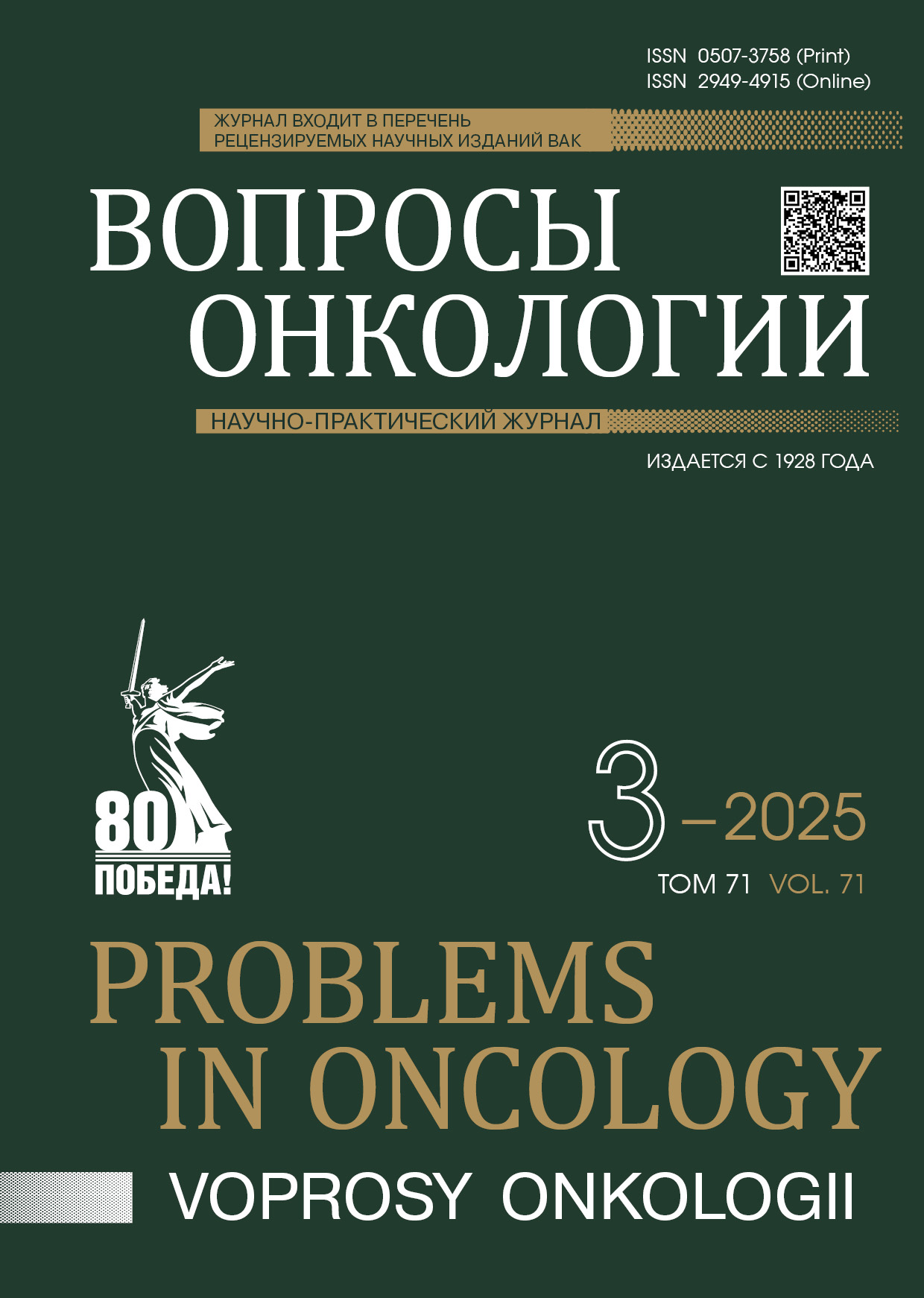Abstract
Introduction. The treatment of triple-negative breast cancer (TNBC) poses a significant clinical challenge due to its unique clinical and pathological characteristics, and the fact that it can develop resistance to existing treatment methods Understanding the characteristics of TNBC, particularly its association with BRCA1 mutations, has enabled the development of various therapeutic approaches, including the use of anthracycline drugs and platinum derivatives. In order to increase the probability of achieving complete pathomorphological regression (pCR) and thereby improving long-term results in the treatment of patients with primary locally advanced TNBC who carry BRCA1 mutations, a study on the use of mitomycin-containing neoadjuvant chemotherapy (NACT) in combination with a platinum agent is currently being conducted at the N.N. Petrov National Medical Research Center of Oncology of the Ministry Health of the Russian Federation.
Aim. To analyze the effectiveness of using a combination of mitomycin and platinum compounds as part of NACT in patients with primary locally advanced TNBC associated with germline variants of BRCA1.
Materials and Methods. The study included 27 patients diagnosed with primary locally advanced BRCA1-associated TNBC. Five patients underwent NACT involving the MR (mitomycin and cisplatin) regimen, followed by surgery and adjuvant therapy (AC-T). Due to the severe nephrotoxicity associated with cisplatin, the NACT regimen was changed to mitomycin and carboplatin, followed by monochemotherapy with paclitaxel (MCarb-T). 22 patients received the MCarb-T regimen.
Results. The pCR rate in the MP group was 2/5 (40 %). 3/5 (60%) patients received a complete NACT regimen with satisfactory blood counts. Systemic therapy was finalized for medical reasons in 2/5 patients. In patients who received the MCarb-T regimen as NACT, the pCR rate was 18/22 (82 %), and the pPR rate was 4/22 (18 %) of cases. Thus, the overall pCR rate when using mitomycin-containing NACT regimens was 20/27 (74 %), and pPR was 7/27 (26 %). During the 3-year follow-up period, there were no cases of relapse or progression of the disease in any of the patients, regardless of the pathomorphological response.
Conclusion. Combining mitomycin with platinum derivatives appears to be a promising approach to systemic neoadjuvant therapy for primary, locally advanced, BRCA1-associated TNBC. Given the high pCR rate, the results of this study deserve further investigation.
References
Karim A.M., Eun Kwon J., Ali T., et al. Triple-negative breast cancer: epidemiology, molecular mechanisms, and modern vaccine-based treatment strategies. Biochem Pharmacol. 2023; 212: 115545.-DOI: 10.1016/j.bcp.2023.115545.
Won K.A., Spruck C. Triple negative breast cancer therapy: Current and future perspectives (Review). Int J Oncol. 2020; 57(6): 1245-1261.-DOI: 10.3892/ijo.2020.5135.
Byrski T., Huzarski T., Dent R., et al. Response to neoadjuvant therapy with cisplatin in BRCA1-positive breast cancer patients. Breast Cancer Res Treat. 2009; 115(2): 359-363.-DOI: 10.1007/s10549-008-0128-9.
Byrski T., Gronwald J., Huzarski T., et al. Pathologic complete response rates in young women with BRCA1-positive breast cancers after neoadjuvant chemotherapy. J Clin Oncol. 2010; 28(3): 375-379.-DOI: 10.1200/JCO.2008.20.7019.
Byrski T., Huzarski T., Dent R., et al. Response to neoadjuvant therapy with cisplatin in BRCA1-positive breast cancer patients. Breast Cancer Res Treat. 2009; 115(2): 359-363.-DOI: 10.1007/s10549-008-0128-9.
Kahmann L., Beyer U., Mehlhorn G., et al. Mitomycin C in patients with gynecological malignancies. Oncourology. 2010; 33(10): 547-557.-DOI: 10.1159/000319742.
Francies F.Z., Wainwright R., Poole J., et al. Diagnosis of Fanconi Anaemia by ionising radiation- or mitomycin C-induced micronuclei. DNA Repair (Amst). 2018; 61: 17-24.-DOI: 10.1016/j.dnarep.2017.11.001.
Moiseyenko V.M., Chubenko V.A., Moiseyenko F.V., et al. Evidence for clinical efficacy of mitomycin C in heavily pretreated ovarian cancer patients carrying germ-line BRCA1 mutation. Med Oncol. 2014; 31(10): 199.-DOI: 10.1007/s12032-014-0199-x.
Gorodnova T.V., Kotiv K.B., Ivantsov A.O., et al. Efficacy of neoadjuvant therapy with cisplatin plus mitomycin C in BRCA1-mutated ovarian cancer. Int J Gynecol Cancer. 2018; 28(8): 1498-1506.-DOI: 10.1097/IGC.0000000000001352.
Gorodnova T.V., Sokolenko A.P., Kondratiev S.V., et al. Mitomycin C plus cisplatin for systemic treatment of recurrent BRCA1-associated ovarian cancer. Invest New Drugs. 2020; 38(6): 1872-1878.-DOI: 10.1007/s10637-020-00965-8.
Legha S.S. A review of mitomycin regimens in advanced breast cancer therapy. Clin Ther. 1985; 7(3): 286-307.
Sokolenko A.P., Gorodnova T.V., Bizin I.V., et al. Molecular predictors of the outcome of paclitaxel plus carboplatin neoadjuvant therapy in high-grade serous ovarian cancer patients. Cancer Chemother Pharmacol. 2021; 88(3): 439-450.-DOI: 10.1007/s00280-021-04301-6.
Myers S.P., Sevilimedu V., Barrio A.V., et al. Pathologic complete response after neoadjuvant systemic therapy for breast cancer in BRCA mutation carriers and noncarriers. NPJ Breast Cancer. 2024; 10(1): 63.-DOI: 10.1038/s41523-024-00674-y.

This work is licensed under a Creative Commons Attribution-NonCommercial-NoDerivatives 4.0 International License.
© АННМО «Вопросы онкологии», Copyright (c) 2025

